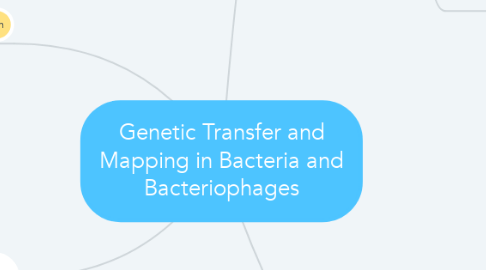
1. Transformation
1.1. uptake from the environment
1.2. only "competent" cells can
1.2.1. require competence factors
1.2.1.1. facilitate DNA binding to cell surface
1.2.1.2. uptake into cytoplasm
1.2.1.3. Integration
2. Horizontal Gene Transfer
2.1. passed to another that is not its offspring
3. Transduction
3.1. involves viruses
3.1.1. bacterial DNA fragment mistakenly packaged into capsid
3.2. Cotransduction
3.2.1. accurate mapping for genes close together
3.2.2. package and transfer of 2 closely linked genes
3.2.2.1. high co-transduction freq= closely-linked
3.2.2.2. co-transduction freq = n(2nd gene | 1st gene)/n(1st gene)
3.2.3. can pack only small amount
3.3. Complementation Test
3.3.1. Mutation in viral genes alter plaque shape
3.3.1.1. plaque formation = complementation present
3.3.2. Mutation in different genes
3.4. Intragenic Mapping
3.4.1. Mutations within a gene
3.4.2. non-complementing produce plaque at low rate
3.4.2.1. High frequency = further apart
3.4.2.2. frequency of recombinant = n(recombinant) or 2x n(wild-type phage)/ n(total phage)
3.5. Deletion Mapping
3.5.1. used to localise many mutations to specific region of a gene
3.5.2. quicker than co-infection mapping
3.5.3. If both genes with deleted areas can still form one complete gene
3.5.3.1. wild-type gene can be formed
3.5.3.1.1. plaques form
4. Conjugation
4.1. require direct contact
4.2. uses Fertility (F) Factor
4.2.1. = plasmids carrying genes required for conjugation
4.2.2. F+
4.2.2.1. Components
4.2.2.1.1. Relaxosome
4.2.2.1.2. Mating Channel
4.2.2.1.3. coupling factor
4.2.2.2. forms sex pili
4.2.2.2.1. attachment sites that promote binding with F-
4.2.2.3. Results
4.2.2.3.1. Donor unchanged
4.2.2.3.2. Recipient becomes F+
4.2.3. Hfr
4.2.3.1. F-factor integrated into bacterial chromosome
4.2.3.1.1. Genes nearest to oriT transmitted most efficiently
4.2.3.2. Results
4.2.3.2.1. Donor unchanged
4.2.3.2.2. Recipient does not become Hfr/F+
4.2.3.2.3. gene recombination occurs
4.3. Gene mapping
4.3.1. determines relative order and distance between genes
4.3.2. Compare time of entry of each gene
4.3.2.1. Distance between gene = time diff (minutes) between gene entry times
4.3.3. f factor can be inserted at...
4.3.3.1. different points
4.3.3.2. different directions
4.3.3.2.1. using anti-sense strand

